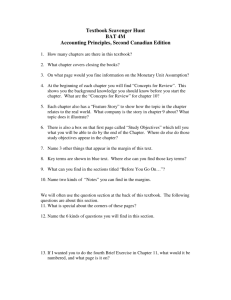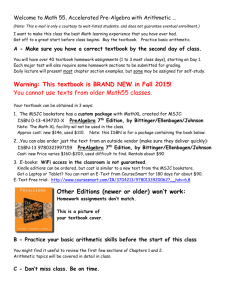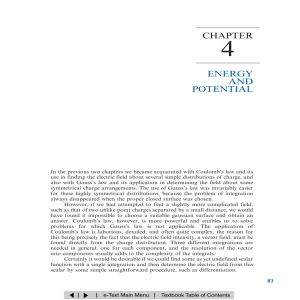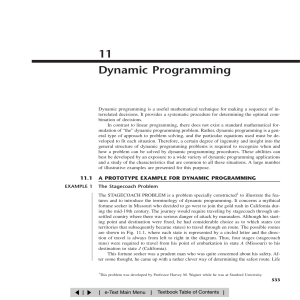Engineering Electromagnetics | | | |
advertisement
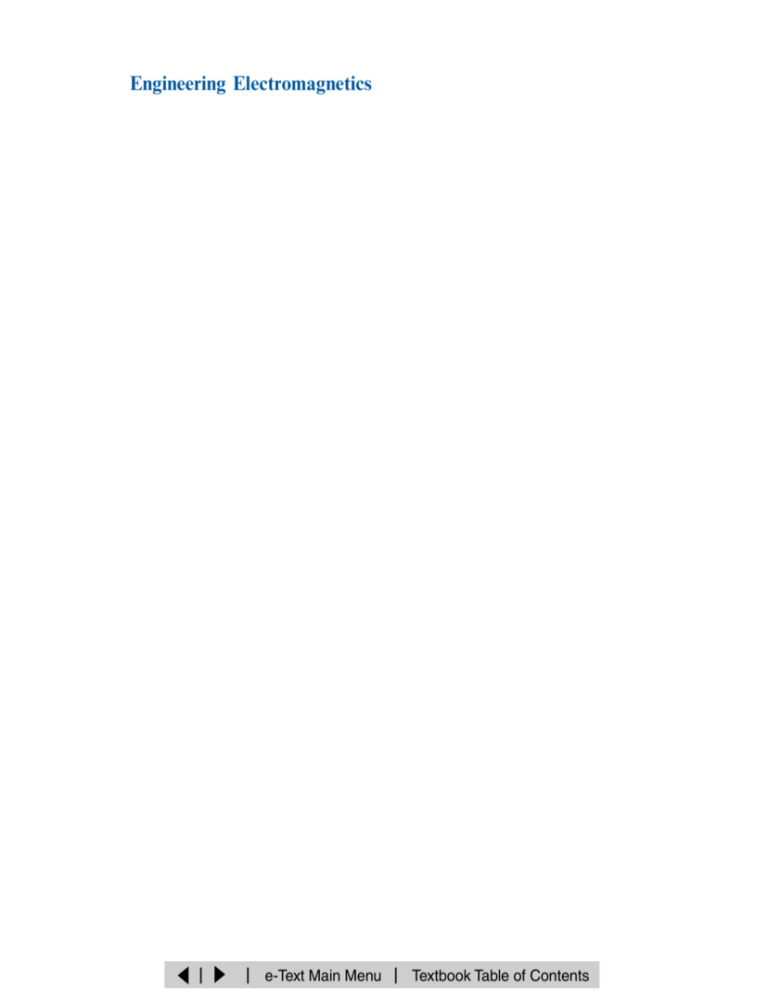
| ▲ ▲ Engineering Electromagnetics | e-Text Main Menu | Textbook Table of Contents | McGraw-Hill Series in Electrical and Computer Engineering SENIOR CONSULTING EDITOR Stephen W. Director, University of Michigan, Ann Arbor Circuits and Systems Communications and Signal Processing Computer Engineering Control Theory and Robotics Electromagnetics Electronics and VLSI Circuits Introductory Power Antennas, Microwaves, and Radar | ▲ ▲ Previous Consulting Editors Ronald N. Bracewell, Colin Cherry, James F. Gibbons, Willis W. Harman, Hubert Heffner, Edward W. Herold, John G. Linvill, Simon Ramo, Ronald A. Rohrer, Anthony E. Siegman, Charles Susskind, Frederick E. Terman, John G. Truxal, Ernst Weber, and John R. Whinnery | e-Text Main Menu | Textbook Table of Contents | Engineering Electromagnetics SIXTH EDITION William H. Hayt, Jr. Late Emeritus Professor Purdue University John A. Buck Georgia Institute of Technology Burr Ridge, IL Dubuque, IA Madison, WI New York San Francisco St. Louis Bangkok Bogotá Caracas Lisbon London Madrid Mexico City Milan New Delhi Seoul Singapore Sydney Taipei Toronto | ▲ ▲ Boston | e-Text Main Menu | Textbook Table of Contents | BRIEF CONTENTS Chapter 1 Chapter 2 Chapter 3 Chapter 4 Chapter 5 Chapter 6 Chapter 7 Chapter 8 Chapter 9 Chapter 10 Chapter 11 Chapter 12 Chapter 13 Chapter 14 Preface xi Vector Analysis Coulomb's Law and Electric Field Intensity Electric Flux Density, Gauss' Law, and Divergence Energy and Potential Conductors, Dielectrics, and Capacitance Experimental Mapping Methods Poisson's and Laplace's Equations The Steady Magnetic Field Magnetic Forces, Materials, and Inductance Time-Varying Fields and Maxwell's Equations The Uniform Plane Wave Plane Waves at Boundaries and in Dispersive Media Transmission Lines Waveguide and Antenna Fundamentals 1 Appendix Appendix Appendix Appendix Appendix Index 27 53 83 119 169 195 224 274 322 348 387 435 484 A Vector Analysis 529 B Units 534 C Material Constants 540 D Origins of the Complex Permittivity E Answers to Selected Problems 544 551 To find Appendix E, please visit the expanded book website: www.mhhe.com/engcs/electrical/haytbuck | ▲ ▲ v | e-Text Main Menu | Textbook Table of Contents | PREFACE Over the years, I have developed a familiarity with this book in its various editions, having learned from it, referred to it, and taught from it. The second edition was used in my first electromagnetics course as a junior during the early '70's. Its simple and easy-to-read style convinced me that this material could be learned, and it helped to confirm my latent belief at the time that my specialty would lie in this direction. Later, it was not surprising to see my own students coming to me with heavily-marked copies, asking for help on the drill problems, and taking a more active interest in the subject than I usually observed. So, when approached to be the new co-author, and asked what I would do to change the book, my initial feeling wasÐnothing. Further reflection brought to mind earlier wishes for more material on waves and transmission lines. As a result, Chapters 1 to 10 are original, while 11 to 14 have been revised, and contain new material. A conversation with Bill Hayt at the project's beginning promised the start of what I thought would be a good working relationship. The rapport was immediate. His declining health prevented his active participation, but we seemed to be in general agreement on the approach to a revision. Although I barely knew him, his death, occurring a short time later, deeply affected me in the sense that someone that I greatly respected was gone, along with the promise of a good friendship. My approach to the revision has been as if he were still here. In the front of my mind was the wish to write and incorporate the new material in a manner that he would have approved, and which would have been consistent with the original objectives and theme of the text. Much more could have been done, but at the risk of losing the book's identity and possibly its appeal. Before their deaths, Bill Hayt and Jack Kemmerly completed an entirely new set of drill problems and end-of-chapter problems for the existing material at that time, up to and including the transmission lines chapter. These have been incorporated, along with my own problems that pertain to the new topics. The other revisions are summarized as follows: The original chapter on plane waves has now become two. The first (Chapter 11) is concerned with the development of the uniform plane wave and the treatment wave propagation in various media. These include lossy materials, where propagation and loss are now modeled in a general way using the complex permittivity. Conductive media are presented as special cases, as are materials that exhibit electronic or molecular resonances. A new appendix provides background on resonant media. A new section on wave polarization is also included. Chapter 12 deals with wave reflection at single and multiple interfaces, and at oblique incidence angles. An additional section on dispersive media has been added, which introduces the concepts of group velocity and group dispersion. The effect of pulse broadening arising from group dispersion is treated at an elementary level. Chapter 13 is essentially the old transmission lines chapter, but with a new section on transients. Chapter 14 is intended as an introduction to waveguides and antennas, in which the underlying | ▲ ▲ xi | e-Text Main Menu | Textbook Table of Contents | PREFACE physical concepts are emphasized. The waveguide sections are all new, but the antennas treatment is that of the previous editions. The approach taken in the new material, as was true in the original work, is to emphasize physical understanding and problem-solving skills. I have also moved the work more in the direction of communications-oriented material, as this seemed a logical way in which the book could evolve, given the material that was already there. The perspective has been broadened by an expanded emphasis toward optics concepts and applications, which are presented along with the more traditional lower-frequency discussions. This again seemed to be a logical step, as the importance of optics and optical communications has increased significantly since the earlier editions were published. The theme of the text has not changed since the first edition of 1958. An inductive approach is used that is consistent with the historical development. In it, the experimental laws are presented as individual concepts that are later unified in Maxwell's equations. Apart from the first chapter on vector analysis, the mathematical tools are introduced in the text on an as-needed basis. Throughout every edition, as well as this one, the primary goal has been to enable students to learn independently. Numerous examples, drill problems (usually having multiple parts), and end-of-chapter problems are provided to facilitate this. Answers to the drill problems are given below each problem. Answers to selected end-of-chapter problems can be found on the internet at www.mhhe.com/engcs/electrical/haytbuck. A solutions manual is also available. The book contains more than enough material for a one-semester course. As is evident, statics concepts are emphasized and occur first in the presentation. In a course that places more emphasis on dynamics, the later chapters can be reached earlier by omitting some or all of the material in Chapters 6 and 7, as well as the later sections of Chapter 8. The transmission line treatment (Chapter 13) relies heavily on the plane wave development in Chapters 11 and 12. A more streamlined presentation of plane waves, leading to an earlier arrival at transmission lines, can be accomplished by omitting sections 11.5, 12.5, and 12.6. Chapter 14 is intended as an ``advanced topics'' chapter, in which the development of waveguide and antenna concepts occurs through the application of the methods learned in earlier chapters, thus helping to solidify that knowledge. It may also serve as a bridge between the basic course and more advanced courses that follow it. I am deeply indebted to several people who provided much-needed feedback and assistance on the work. Glenn S. Smith, Georgia Tech, reviewed parts of the manuscript and had many suggestions on the content and the philosophy of the revision. Several outside reviewers pointed out errors and had excellent suggestions for improving the presentation, most of which, within time limitations, were taken. These include Madeleine Andrawis, South Dakota State University, M. Yousif El-Ibiary, University of Oklahoma, Joel T. Johnson, Ohio State University, David Kelley, Pennsylvania State University, Sharad R. Laxpati, University of Illinois at Chicago, Masoud Mostafavi, San Jose State University, Vladimir A. Rakov, University of Florida, Hussain Al-Rizzo, Sultan | ▲ ▲ xii | e-Text Main Menu | Textbook Table of Contents | PREFACE Qaboos University, Juri Silmberg, Ryerson Polytechnic University and Robert M. Weikle II, University of Virginia. My editors at McGraw-Hill, Catherine Fields, Michelle Flomenhoft, and Betsy Jones, provided excellent expertise and supportÐparticularly Michelle, who was almost in daily contact, and provided immediate and knowledgeable answers to all questions and concerns. My seemingly odd conception of the cover illustration was brought into reality through the graphics talents of Ms Diana Fouts at Georgia Tech. Finally, much is owed to my wife and daughters for putting up with a part-time husband and father for many a weekend. | ▲ ▲ John A. Buck Atlanta, 2000 | e-Text Main Menu | Textbook Table of Contents | xiii



